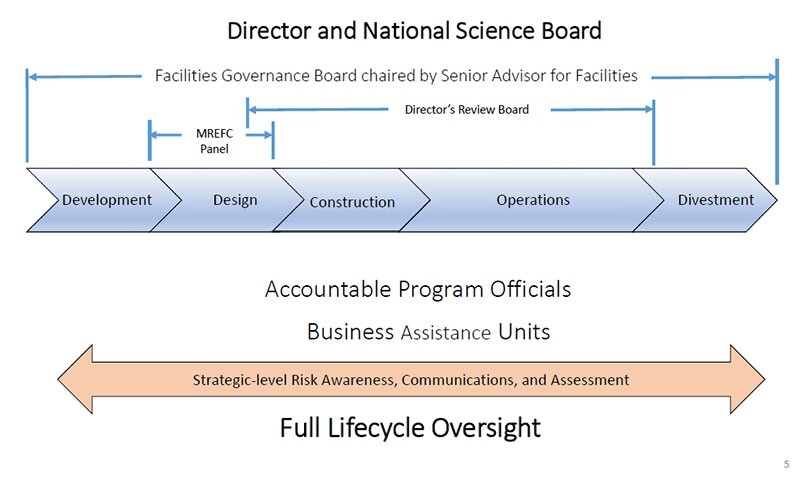
A slide depicting the scope of the Facilities Governance Board’s oversight responsibilities.
(Image credit – NSF)
At the fall meeting
As part of its implementation of AICA, NSF plans to create a Facilities Governance Board (FGB) chaired by a new senior facilities advisor that will oversee the agency’s major research infrastructure projects at all stages of their lifecycles, from concept development through divestment.
The board is intended to complement existing oversight panels that only focus on certain stages of the facilities lifecycle. Furthermore, its purview will extend beyond facilities funded through the Major Research Equipment and Facilities Construction (MREFC) budget account to include smaller research infrastructure projects.
Fae Korsmo, a senior advisor in the Office of the NSF Director, explained that NSF arrived at the decision to create the FGB after synthesizing requirements of AICA with recommendations from the National Academy of Public Administration and the agency’s Business and Operations Advisory Committee (BOAC).
Currently, while the NSF director and the NSB together have the ultimate oversight responsibility for the agency’s large portfolio of facilities
The subcommittee observed that this contrasts with facility management procedures used by the Department of Energy and NASA, which require high-level approvals during concept development and operations phases. Accordingly, the subcommittee recommended that NSF assign the MREFC Panel analogous responsibilities.
Korsmo said NSF ultimately decided not to expand the scope of the panel. “We have tried to stretch [the MREFC Panel] this way and that way, up and down, across,” she remarked. Instead NSF chose to create the FGB, which she said she envisions as being a small “agile risk group” comprising at least three senior executives.

A slide depicting the scope of the Facilities Governance Board’s oversight responsibilities.
(Image credit – NSF)
NSB members appeared to support the FGB idea, although a few expressed concerns about the implications of adding another layer of oversight. “I always have similar kinds of concerns when we build super-structures,” said Vint Cerf, an NSB member and a vice president at Google. “The one thing which I would worry about is: who has what authority, and where will the tensions be when there’s disagreement about risk and risk taking?”
He continued, “My guess would be you’re just going to have to live through that and figure out how to make it work. I would raise a little pink flag that, speaking of risk, there’s a risk of creating a real serious and potentially hazardous debate that inhibits your ability to make decisions.”
NSF Director Córdova elaborated on the central motivation for the new oversight structure:
The major purpose of doing this when you look at the requirements of the AICA and the other recommending reviews is one word, and that’s ‘oversight.’ We haven’t been clear about where the oversight is and how the Office of the Director and the National Science Board get the information that they need.
Underscoring that the FGB will have broad purview over facilities, Córdova said, “This is going to include not just MREFC projects that we’ll have oversight for, but any project, no matter what its size, that is considered sensitive, in all uses of that word, and definitely mid-scale as we go forward with developing a mid-scale program
Córdova also outlined the FGB’s general role in fleshing out how NSF handles projects at the beginning and end of their lifecycles.
“There are many questions about how projects get conceived, that’s over at the development end, and [questions] about how they wind down on the divestment end, which you know the board is handling in real time,” she began, alluding to a vote the NSB was scheduled to take later that day on NSF’s divestment process for the Arecibo Observatory in Puerto Rico. NSF announced
Córdova continued, “Those will be challenges for the chief facilities officer and the Facilities Governance Board to wrestle with, again with input from the whole agency. But they’re really responsible for how does it all work, and what are the rules of the road, and how do we identify things of consequence wherever they occur in the big scope of all facilities and bring it up to the level of the director and the board.”